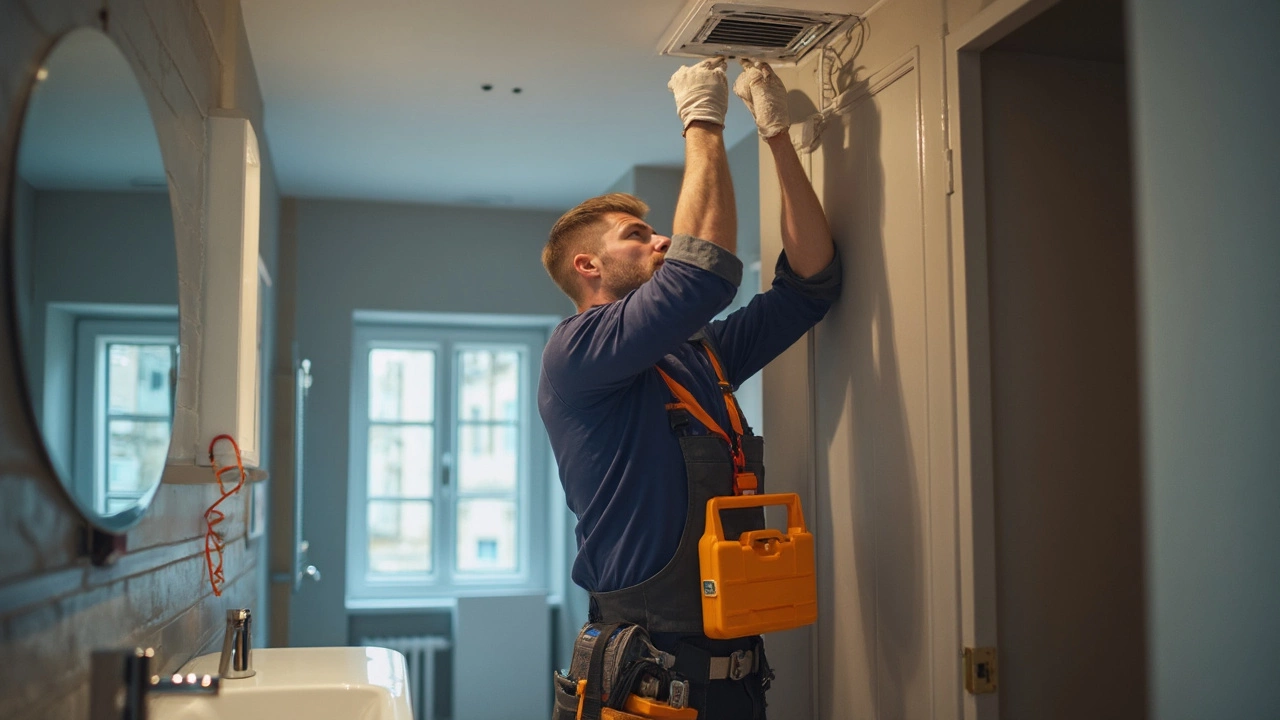Standing under a spluttering extractor fan that barely pulls any steam? You’re not alone. These fans get a workout—especially in bathrooms and kitchens—and sooner or later, they quit. The next question is simple: Who actually goes about replacing an extractor fan?
A lot of folks think you just unscrew the old one and stick in a new one, but it’s not always that straightforward. Wiring, regulations, and proper venting trip up plenty of DIY hopefuls. A botched replacement can mean mold, damp, or blowing a fuse—none of which you want on your day off.
If your fan makes scary noises, refuses to run, or just doesn’t shift air like it used to, it’s time to act. The next sections get into who’s qualified, what parts you might need, and why some jobs are perfect for rolling up your sleeves while others are best left to someone with an electrician’s license (and maybe better insurance than you). Stay tuned for tips that can save your wallet, your weekend, and your bathroom ceiling from going green with mold.
- Why Extractor Fans Fail
- Who’s Qualified to Replace One?
- When DIY Makes Sense
- Hiring the Right Professional
- Cost Breakdown and Money-Saving Tips
- Aftercare and Preventing Future Problems
Why Extractor Fans Fail
Most extractor fans don’t just stop working out of nowhere. They build up problems over time, and knowing what actually kills them helps you fix or replace only what matters. The biggest culprit? Dust, grease, and moisture—these wreck small motors faster than you think.
When air filters and fan blades get caked with gunk, airflow drops down and the fan works harder. In kitchens, sticky grease coats everything. In bathrooms, it’s fluff and damp that cakes the blades. Electric motors hate resistance, so they burn out trying to spin through all this crud. Sometimes, moisture even gets inside the wiring and causes shorts.
- Dust and grease buildup slows blades and motor
- Moisture leads to rust or shorts, especially in bathrooms
- Old, worn bearings make fans rattle or seize up
- Dodgy wiring (from either age or sloppy installation) cuts fan life short
- Low voltage or electrical spikes fry the fan’s electronics
Just to show how common these problems are, here’s a quick look at what usually goes wrong, based on actual repair visits I’ve seen on the job:
| Common Failure Cause | Estimated Share (%) |
|---|---|
| Dust/grease buildup | 35 |
| Electrical fault | 25 |
| Motor burnout | 20 |
| Moisture/rust | 15 |
| Physical damage | 5 |
One easy tip that keeps a fan healthy: clean the cover and blades every few months. Most people never do, and that’s usually what sends the fan to an early grave. And if you notice a rattling sound, don’t ignore it. That’s your extractor fan asking for help—catch it early, and you might not need a full-on replacement next time.
The extractor fan is a workhorse, but it’s got its limits. Treat it right and you won’t be on first-name terms with your local electrician nearly as often.
Who’s Qualified to Replace One?
If you think swapping out an extractor fan is a job for anyone, think again. The job can seem simple at first—unscrew, unplug, swap, and done. But the second you peek behind the cover and see wires or spot signs of dampness, it’s clear you might be in over your head. So, who actually qualifies for this?
If you live in the UK, there are clear rules. The law says any electrical work near water, like in a bathroom, usually has to be done or at least certified by someone registered with a scheme like NICEIC or NAPIT. Got no clue what those are? They're just groups that approve real, trained electricians—not your mate with a screwdriver and YouTube access.
For simple repairs—like changing a cover or cleaning out dust—most homeowners can manage with everyday tools. But as soon as you need to touch wiring, it’s another story, especially if you’re in a rented place or planning to sell soon. Uncertified DIY jobs can cause trouble with insurance or during a home sale.
So, here’s the quick breakdown on extractor fan replacement:
- If your fan plugs into a standard outlet and isn’t hardwired, you can probably handle it yourself.
- If you have to deal with wiring, switches, or the unit is above a bath or shower, hire a qualified electrician. Not only is it safer, it’s required by UK building regs.
- Check if your area also needs notification to the local authority for certain types of work—especially in bathrooms.
Electricians don’t just swap the fan; they look for signs of something worse, like poor insulation or hidden leaks. Some handymen also replace fans, but make sure they’re certified for electrical work. Bottom line: whenever in doubt, especially if wiring’s involved, let a pro take care of it. Your nerves, insurance, and safety will thank you.
When DIY Makes Sense
If you’re handy and feel confident flipping a breaker, a basic extractor fan swap isn’t rocket science. Old fans in bathrooms or kitchens tend to use standard sizes, and most use just a couple of wires. The trick is knowing when your skills are enough and when it’s smarter to call in a pro.
DIY makes sense if your fan is just a simple model—no timer, humidity sensor, or fancy lights. If you have access to the old wiring, you can safely switch the circuit off, and you’re not dealing with any crumbling plaster or hidden surprises, you’re in a good spot to give it a go.
- The new fan matches the size and shape of the old cutout and ducting.
- You can clearly see the wiring—usually live, neutral, and sometimes earth wires (check your local wiring color codes).
- There’s no damage to the surrounding wall or ceiling.
- The fan isn’t tied into complicated setups with lighting or smart switches.
Before starting, grab a voltage tester and double-check the power is truly off—never just trust the wall switch. If you’re not sure about the wiring or the connections look sketchy, pause and get help. UK building rules say certain electrical jobs in bathrooms and kitchens have to be signed off by a certified electrician, so if in doubt, check your local regulations.
Not ready to mess with wires? Swapping out a loose cover, cleaning out the grill, or replacing filters can usually be done with nothing more than a screwdriver and a little patience. But if you’re facing stubborn screws, tangled wires, mystery damp patches, or a buzzing noise coming from the fuse box when the fan’s on, quit while you’re ahead and hit up a professional. Safety (and working lights) is worth way more than saving a few quid on a callout.

Hiring the Right Professional
If you’re looking to skip the hassle and cut the risk, hiring a pro to handle your extractor fan replacement is smart. This isn’t one of those jobs you want to give to “a friend who’s good with tools” unless he also understands wiring and local building codes.
Electricians are usually your best bet. To legally deal with electrical wiring in most places, you either need the right qualifications or you need to hire someone who has them. For example, in the UK, replacing an extractor fan in a kitchen or bathroom can fall under Part P of the Building Regulations, meaning it’s technically not a DIY gig unless you’re a certified electrician. In the USA, state and local codes also set the rules—get them wrong and you could void your insurance.
When you’re picking a pro, don’t settle for the first name from an online ad. Here’s what to check:
- License and Insurance: Always ask to see proof. In 2022, nearly 28% of home repair complaints in the UK were because of dodgy credentials.
- Experience: Make sure they’ve swapped and installed plenty of extractor fans before—not just general electrical work.
- Reviews: Google, Trustpilot, and even your local Nextdoor group can warn you about unreliable companies or hidden fees.
- Upfront Pricing: Get a written, itemized quote. Good pros don’t mind explaining costs.
What should you expect to pay? Check out this ballpark data:
| Country | Average Cost for Replacement |
|---|---|
| UK | £80-£250 (parts & labor) |
| USA | $100-$300 (parts & labor) |
| Australia | $150-$350 AUD (parts & labor) |
Some companies offer fixed-price installs, but if your wiring or venting is outdated, expect extra charges. An honest professional will tell you this upfront and explain your options.
If your extractor fan is linked to a light, timer, or humidity sensor, mention it before booking—these add time (and sometimes cost). Not all electricians will tackle venting through a wall or roof, so double check before you hire.
Bottom line: Get someone who doesn’t just know the wires, but understands the way your fan fits into your kitchen or bathroom setup. You’ll get a safer, longer-lasting fix and peace of mind that it’s all to code.
Cost Breakdown and Money-Saving Tips
If you’re dreading the bill for a new extractor fan, relax—this isn’t one of those jobs that always breaks the bank. Here’s how the numbers shake out so you can plan your next steps, and squeeze out some extra savings, too.
The price you pay depends on a few things: the type of fan, the brand, labor rates in your area, and whether any wiring or ducting needs work. To give you a proper idea, here’s a table that lays out the typical costs in the UK:
| Item/Service | Low End (£) | High End (£) |
|---|---|---|
| Basic extractor fan (non-ducted) | £20 | £50 |
| Mid-range bathroom/kitchen fan | £50 | £120 |
| Premium smart/extractor fan | £120 | £250 |
| Professional installation (labor only) | £70 | £150 |
| Disposal/old fan removal | £10 | £30 |
If your job only needs swapping out an old fan for a similar new one, the low end of these ranges is more likely—especially if you shop around. But if wiring is outdated or there’s no access above the ceiling, costs jump quickly.
Where can you save? A few tried-and-true tricks:
- Buy your extractor fan directly online, avoiding tradesperson markups on parts.
- Ask for a fixed quote, not an hourly rate—it stops any nasty surprises from dragging out the job.
- Get at least three quotes. Seriously, prices can swing a lot between local electricians.
- See if your old grill or ductwork is still good. No point in replacing things that aren’t broken (and pros sometimes swap these out for convenience).
- If you’re handy and the wiring’s already set up, you can swap the unit yourself and skip labor costs. Just make sure you flip the right circuit breaker!
A trusted resource on home repairs, Which?, says it straight:
“A simple, like-for-like extractor fan replacement is well within the skills of most confident DIYers, but do not attempt anything involving new wiring unless you’re qualified. Electrical safety is non-negotiable.”
Sometimes it’s tempting to go cheap, but quality matters. A bargain-bin fan might not move enough air, or could rattle itself loose in a year. Go for a unit with good reviews and a long warranty—many solid models promise five years of hassle-free use.
One last tip: if your extractor fan’s still under warranty, you could get it swapped for free. Check your paperwork or ask the manufacturer before you whip out your toolbox or phone.
Aftercare and Preventing Future Problems
So, your extractor fan is finally sorted. What now? Don’t just forget about it. Giving your new or repaired fan some basic care keeps it humming along and stops problems from sneaking up on you again.
First off, dust is your enemy. Every few months, turn off the fan at the wall and pop off the cover. Wipe down the blades and grill with a dry cloth or a soft brush. This quick step stops blockages that choke airflow and overwork the fan motor.
Next, take a look at any vent ducts you can reach. Lint, grease, and cobwebs love to clog these up—especially in kitchen setups. If your fan vents outside, check for nests or buildup around the exit flap. A quick clean twice a year helps boost efficiency and stops the duct from getting smelly or even leaking back into your room.
- If your fan has a filter (some kitchen fans do), swap or wash it every six months. A gunked-up filter can block air and kill your fan’s power.
- Check for signs of excess moisture or mold on walls and ceilings near the fan, especially in bathrooms. That’s usually a sign the fan isn’t shifting enough air. If you spot trouble, see if the window stays fogged up after showers or if the fan sounds weaker than usual.
- Listen for odd noises—rattling or grinding might mean a loose screw or tired bearings. Catch these early, and you might avoid another full replacement.
It’s smart to test the fan regularly. Let it run for a bit and hold up a tissue to the vent; if it sucks in, you’re good. If not, airflow might be blocked, so take another look at the duct or the fan blades.
And finally, keep an eye on the fuse box. If the fan starts tripping fuses or you see flickering lights, call out a pro right away. Electrical problems are not DIY territory.
Staying on top of these small tasks means your extractor fan does its job—keeping air clean, dry, and safe—without surprise costs or headaches down the line.




